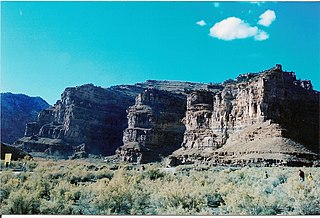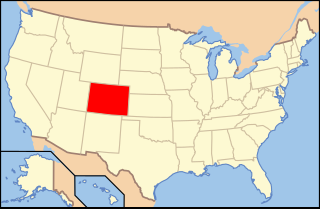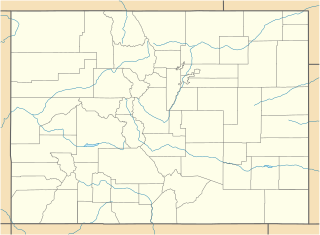
Lees Ferry is a site on the Colorado River in Coconino County, Arizona in the United States, about 7.5 miles (12.1 km) southwest of Page and 9 miles (14 km) south of the Utah–Arizona border.

Dinosaur National Monument is an American national monument located on the southeast flank of the Uinta Mountains on the border between Colorado and Utah at the confluence of the Green and Yampa rivers. Although most of the monument area is in Moffat County, Colorado, the Dinosaur Quarry is located in Utah, north of the town of Jensen, Utah at 40°26′29″N109°18′04″W. The nearest Colorado town is Dinosaur while the nearest city is Vernal, Utah.

El Morro National Monument is a U.S. national monument in Cibola County, New Mexico, United States. Located on an ancient east–west trail in the western part of the state, the monument preserves the remains of a large prehistoric pueblo atop a great sandstone promontory with a pool of water at its base, which subsequently became a landmark where many centuries of explorers and travelers left historic inscriptions that survive today.

Navajo National Monument is a National Monument located within the northwest portion of the Navajo Nation territory in northern Arizona, which was established to preserve three well-preserved cliff dwellings of the Ancestral Puebloan People: Keet Seel, Betatakin, and Inscription House. The monument is high on the Shonto plateau, overlooking the Tsegi Canyon system, west of Kayenta, Arizona. It features a visitor center with a museum, two short self-guided mesa top trails, two small campgrounds, and a picnic area. Rangers guide visitors on free tours of the Keet Seel and Betatakin cliff dwellings. The Inscription House site, further west, is currently closed to public access.

This is a directory of properties and districts listed on the National Register of Historic Places in Utah, USA. There are more than 1,800 listed properties in Utah. Each of the 29 counties in Utah has at least two listings on the National Register.

There are more than 1,500 properties and historic districts in Colorado listed on the National Register of Historic Places. They are distributed over 63 of Colorado's 64 counties; only Broomfield County has none.

Ninemile Canyon is a canyon, approximately 40 miles (64 km) long, located in Carbon and Duchesne counties in eastern Utah, United States. Promoted as "the world’s longest art gallery", the canyon is known for its extensive rock art, most of it created by the Fremont culture and the Ute people. The rock art, shelters, and granaries left behind by the Fremont make Ninemile Canyon a destination for archaeologists and tourists alike.

The Hole in the Rock Trail is a historic trail running east-southeast from the town of Escalante in southern Utah in the western United States. The Mormon trailblazers who established this trail crossed the Colorado River and ended their journey in the town of Bluff. The Hole-in-the-Rock expedition established the trail in 1879. The trail is located within the borders of the Grand Staircase-Escalante National Monument, the adjacent Glen Canyon National Recreation Area and federal Bureau of Land Management (BLM) public land to the east of the Colorado River. A geologic feature called the Hole in the Rock gave the trail its name. A modern unpaved road called the Hole-in-the-Rock Road closely follows this historic trail to the point where it enters the Glen Canyon National Recreation Area. The modern road is an important access route for visiting the Canyons of the Escalante and the Devils Garden. The trail is listed on the National Register of Historic Places, being added to that list in 1982.

Desolation Canyon is a remote canyon on the Green River in eastern Utah, United States that is listed on the National Register of Historic Places (NRHP). It is said to be one of the remotest areas in the contiguous United States.

The following is an alphabetical list of articles related to the U.S. state of Colorado.

The Mines of Spain State Recreation Area and E. B. Lyons Nature Center is a state park in Dubuque County, Iowa, United States. It is near Dubuque, the eighth-largest city in the state. The park features picnic areas, 15 miles (24 km) of walking/hiking trails, 4 miles (6.4 km) of ski trails, and the Betty Hauptli Bird and Butterfly Garden. It also includes archaeological sites of national importance as an early lead mining and smelting venture led by French explorer Julien Dubuque, as well as Dubuque's gravesite. These sites were collectively designated a National Historic Landmark District as Julien Dubuque's Mines.

Cataract Canyon is a 46-mile-long (74 km) canyon of the Colorado River located within Canyonlands National Park and Glen Canyon National Recreation Area in southern Utah. It begins at the Colorado's confluence with the Green River and its downstream terminus is the confluence with the Dirty Devil River. The lower half of the canyon is submerged beneath Lake Powell when the lake is at its normal high water elevation of 3,700 feet (1,100 m).
This is a list of the National Register of Historic Places listings in Dinosaur National Monument.

The Julien Inscription Panel is a rock face in Arches National Park that has been marked by passers-by who have incised their names into the desert varnish on the sandstone rock of the vertical rock face. Most of the signatures have been added since 1900. The most significant inscription was left by Denis Julien, a French-American trapper who traveled throughout the American southwest, leaving his mark as he went. The Julien inscription dates to June 9, 1844. The site also includes some prehistoric petroglyphs.

Inscription "B" is a survey mark that was left at the confluence of the Colorado and Green rivers in Utah in 1889 by the Robert Brewster Stanton party as they surveyed a railway route. The inscription reads:
STA 84. 89 + 50
D. C. C. &.P. R.R.
May 4th 1 8 8 9

The Denis Julien Inscription is an incised carving on a rock face in a side canyon of the Green River north of Canyonlands National Park in Utah. The site is about 750 feet (230 m) to the east of the Green River in Hellroaring Canyon, at the top of a talus slope. The inscription was left by trapper Denis Julien in 1836, when he was one of the few Europeans in southern Utah. The panel reads:
D. Julien
1836
3 mai
Denis Julien Inscription may refer to one of four incised panels on rocks in southern Utah left by trapper Denis Julien in the 1830s and 1840s.
Denis Julien was an American fur trapper of French-Canadian Huguenot origin best known for his activity in the southwestern United States in the 1830s and 1840s, at a time when he was one of the few people of European descent in the area. He is principally remembered for his habit of leaving carved inscriptions on rock faces in Utah and Colorado during his travels. At least eight such markings have been positively attributed to him, four of which are listed on the National Register of Historic Places.

The Denis Julien Inscription was left on a rock face in 1838 along the Green River in Moffat County, Colorado by Denis Julien, a French-American trapper who was one of the few Europeans in the area in the 1830s. Julien made a practice of leaving his mark on locations along the Green and Colorado rivers, leaving at least eight such marks. Four, including the Colorado mark, are listed on the National Register of Historic Places.
Frederick Albert Hale was an American architect who practiced in states including Colorado, Utah, and Wyoming. According to a 1977 NRHP nomination for the Keith-O'Brien Building in Salt Lake City, "Hale worked mostly in the classical styles and seemed equally adept at Beaux-Arts Classicism, Neo-Classical Revival or Georgian Revival." He also employed Shingle and Queen Anne styles for several residential structures. A number of his works are listed on the U.S. National Register of Historic Places.
















